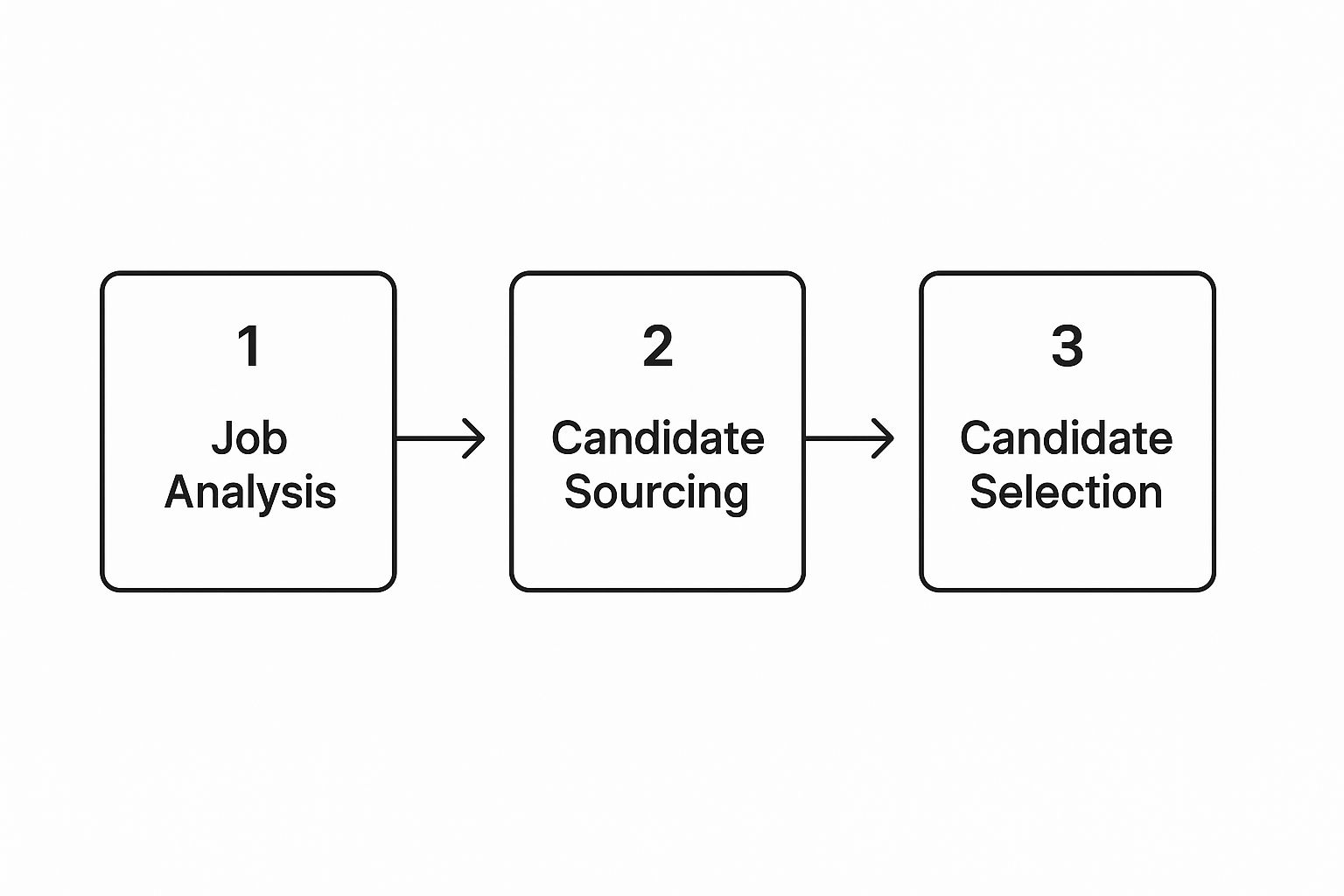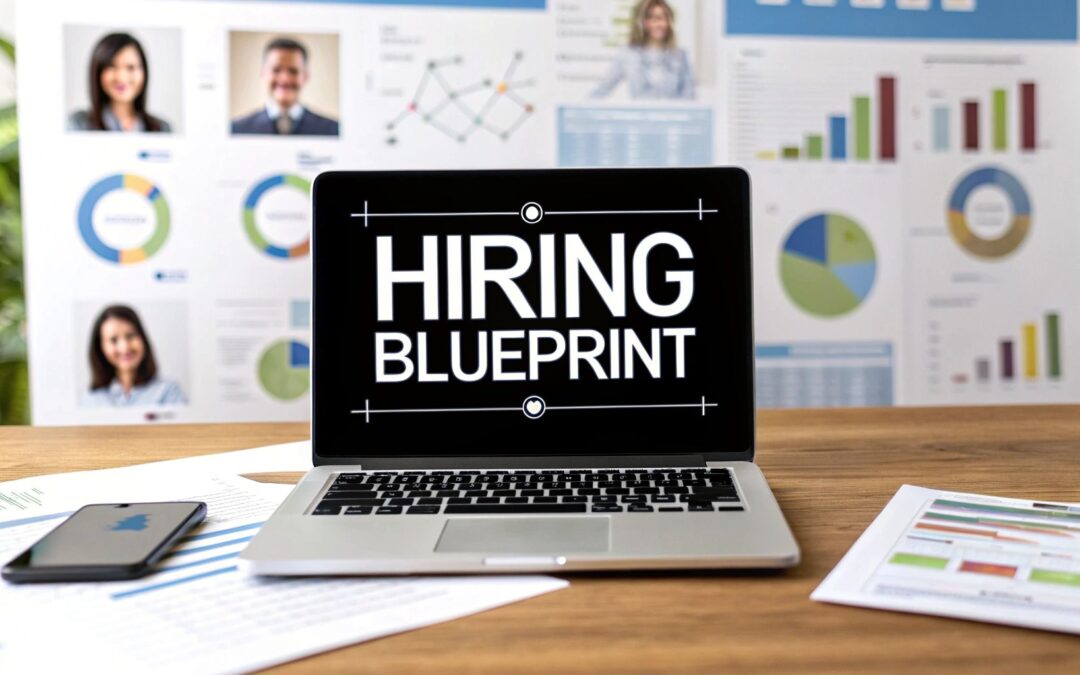The recruitment process in human resource management isn't just about filling a seat—it's the strategic engine that builds a winning team. Think of it less like a checklist and more like a core business function that directly fuels growth and innovation.
What Is the Modern Recruitment Process
Building a high-performing company feels a lot like assembling a championship sports team. You're not just looking for bodies to fill positions; you need star players who excel in their roles and contribute to a unified game plan. The recruitment process has evolved far beyond simply posting a job ad. Today, it’s a critical tool for gaining a genuine competitive edge.
But modern businesses are up against a tough opponent: a massive skills gap where the demands of the job are evolving faster than the available talent can keep up.
The Challenge of Today's Hiring Market
It's not just you—hiring is hard. A staggering 76% of employers globally report struggling to find the right people for their open roles. This isn't just a fluke; it's a persistent mismatch between the skills companies need and the qualifications people have.
In fact, 63% of employers point to this very skills gap as the number one thing holding back their business transformation. This new reality makes a structured, forward-thinking recruitment lifecycle absolutely non-negotiable. The old "post and pray" method just doesn't cut it anymore. For a deeper dive, it's worth exploring different approaches for streamlining your recruitment process.
A truly effective recruitment strategy is proactive, not reactive. It anticipates future talent needs and builds a continuous pipeline of qualified candidates, ensuring the organization is always prepared for growth and change.
An Overview of the Recruitment Lifecycle
A well-defined recruitment process gives you a reliable framework for making consistent, high-quality hiring decisions. It ensures every candidate gets a fair shake and, just as importantly, gets all your hiring managers on the same page about what "good" actually looks like for a role.
The recruitment journey can be broken down into seven core stages. This table provides a quick snapshot of the entire lifecycle, from the initial spark of a need to a new team member's first day.
The Seven Core Stages of the Recruitment Process
| Stage Number | Stage Name | Primary Goal |
|---|---|---|
| 1 | Job Requisition | To get formal approval and budget for a new hire. |
| 2 | Sourcing | To find and attract a diverse pool of qualified candidates. |
| 3 | Screening | To quickly filter applications and identify top contenders. |
| 4 | Interviewing | To assess skills, experience, and cultural fit in-depth. |
| 5 | Offer and Negotiation | To present a competitive offer and secure the best candidate. |
| 6 | Hiring | To complete all pre-employment checks and paperwork. |
| 7 | Onboarding | To integrate the new hire smoothly into the team and company. |
Each step builds on the last, creating a logical flow that turns a complex task into a manageable process. We'll be diving much deeper into each of these stages.
The infographic below gives a great visual of how these foundational stages work together.

Mastering this entire lifecycle is what elevates recruiting from an administrative headache into a powerful driver of long-term business success.
Building Your Hiring Blueprint

Great hiring doesn't start with a job post. It starts way earlier, with a solid plan. This initial stage is easily the most important part of the entire recruitment process in human resource management. Think of it like an architect drafting a detailed blueprint before a single brick is laid—without that careful prep work, the whole structure could end up unstable.
This is where you shift from reactive hiring (that mad dash to fill an empty seat) to proactive, strategic workforce planning. It’s about taking a hard look at your current team, identifying strengths and weaknesses, and thinking about what skills you’ll need six months or a year down the road. This kind of foresight keeps you ahead of the curve, preventing talent gaps before they become real problems.
Performing a Thorough Job Analysis
The foundation of your entire hiring blueprint is a comprehensive job analysis. This goes far beyond just jotting down a list of daily tasks. It’s a deep dive into what it truly takes for someone to succeed in the role, from their core responsibilities to the subtle personality traits that make them a great fit for your company’s vibe.
A proper analysis gets crystal clear on three key things:
- Role Responsibilities: What are the absolute must-do, non-negotiable duties of this job?
- Required Competencies: What specific hard skills (like software proficiency) and soft skills (like communication or creative problem-solving) are essential for success?
- Cultural Contribution: How will this person interact with other teams? What kind of personality will add something positive to your existing culture?
Getting this right means you’re hiring a whole person, not just a set of skills. This strategic work also brings clarity to another big question: which roles absolutely need to be in-house versus which could be handled by a partner? As you map out your talent strategy, it's worth exploring the benefits of outsourcing HR and recruitment to see how you can best allocate your resources.
The real goal of a job analysis is to create a 360-degree profile of your ideal hire. This clarity prevents so many headaches later on, saving you countless hours and reducing the risk of a bad hire—a mistake that can cost a company between 15% and 21% of that employee’s annual salary.
Crafting a Compelling Job Description
With a solid analysis done, it’s time to turn that insight into a compelling job description. This isn't just an internal document; it's your number one marketing tool for attracting top talent. It needs to be clear, engaging, and, most importantly, honest. It’s the first real touchpoint a candidate has with your company, so it has to set the right expectations from the get-go.
Don't do this in a silo. Grab the department heads and team leaders who will be working with this new hire. They’re in the trenches every day and know exactly what it takes to thrive. Getting their input ensures everyone is aligned on the target before the search even kicks off.
A truly effective job description will:
- Open with a strong summary that sells the role and your company.
- Clearly outline the main duties using active, engaging language.
- Separate "must-have" skills from "nice-to-haves" to avoid scaring off great candidates.
- Paint a picture of the team and company culture so people can see themselves working there.
Managing these documents can get repetitive, which is where automation can be a lifesaver. You can learn more about how business process automation can standardize your job descriptions and streamline other HR tasks. With this blueprint finalized, you're now perfectly set up to find and attract the exact talent you've so carefully defined.
Sourcing and Attracting Top Talent

Once your hiring blueprint is locked in, the real hunt begins. This is the recruitment process in human resource management where you actually go out and find the people who will become your next great team members.
Think of it like fishing. A seasoned angler knows you can't just toss any old bait in the water and hope for the best. You need the right lure, the right spot, and the right technique for the specific fish you want to catch. The same logic applies to talent—a generic, one-size-fits-all approach just doesn't work anymore.
The mission here is to build a powerful sourcing strategy that pulls from multiple channels, creating a deep and diverse talent pipeline. This means blending tried-and-true methods with more modern tactics to meet candidates wherever they are.
Differentiating Between Internal and External Sourcing
Before you cast your net far and wide, it's always smart to look in your own backyard first. Internal sourcing—promoting or transferring your current employees—is a hugely effective strategy that’s often overlooked.
It’s a fantastic way to reward loyalty and boost morale. Plus, it drastically cuts down on ramp-up time, since internal hires already know the company culture, the systems, and the key players.
But relying only on internal talent can create an echo chamber, starving your teams of fresh ideas. That’s where external sourcing becomes critical. Looking outside the company brings in new perspectives, diverse experiences, and specialized skills you might not have in-house. A healthy recruitment engine knows how to strike a balance between nurturing homegrown talent and bringing in new energy.
Crafting a Multi-Channel Sourcing Strategy
A strong sourcing plan never puts all its eggs in one basket. Instead, it weaves together several different channels to maximize reach and attract a wide range of qualified applicants. This is your best defense against ending up with a shallow talent pool.
Here are a few essential channels for any modern recruitment playbook:
- Job Boards: They might feel old-school, but giants like LinkedIn and Indeed are still workhorses for reaching a high volume of active job seekers. The trick is to write job descriptions that pop.
- Social Media Recruiting: You have to go where the talent hangs out. LinkedIn is the obvious choice for professional roles, but don’t ignore other platforms where your ideal candidates might be scrolling. A behind-the-scenes look at your company culture can be a massive draw.
- Professional Networking: Get out there! Attending industry events, joining webinars, and participating in online forums helps build your employer brand. It also connects you with passive candidates—those talented folks who aren't actively looking but would be open to the right opportunity.
- Employee Referral Programs: Your own employees are one of your best recruiting assets. They have networks full of qualified peers and can give an authentic pitch for why your company is a great place to work. Referrals are consistently a top source for quality hires, and these employees tend to stick around longer.
A well-designed employee referral program can be a total game-changer. The data doesn't lie: referred candidates get hired faster, perform better on the job, and have higher retention rates. It effectively turns every single employee into a talent ambassador.
For highly specialized roles, especially in tech fields like AI, your sourcing has to get even more granular. If you're hunting for niche skills, you might need to call in the specialists. For example, finding experts for a specific platform requires a targeted search, which is why many companies partner with the best staffing companies for automated speech recognition to build out their teams.
By diversifying your methods and tailoring them to the role, you create a sustainable pipeline that feeds you a steady stream of qualified, engaged, and diverse applicants.
Screening and Selecting Your Best Candidates

You’ve cast your net and brought in a pool of applicants—now the real work begins. The recruitment process in human resource management pivots from attracting candidates to carefully identifying the very best ones for your team. This stage is all about quality over quantity.
Think of it as running a series of progressively finer filters. Each step isn't just about weeding people out; it’s about getting closer to that perfect-fit candidate who will not only excel in the role but also add something valuable to your company culture.
Cutting Through the Noise with Initial Screening
That first filter can feel overwhelming. For a popular opening, you could be staring at a mountain of hundreds of applications. Going through them one by one is not just slow, it’s a recipe for burnout and inconsistent evaluation. This is where an Application Tracking System (ATS) becomes a recruiter’s best friend.
An ATS does the heavy lifting by scanning resumes for the specific keywords, skills, and qualifications you outlined in the job description. It instantly surfaces the most promising applicants, letting your team focus their energy on engaging with people instead of getting buried in paperwork.
By automating the top of your hiring funnel, you’re not just speeding things up. You’re also creating a more standardized and fair starting line for every candidate, which helps minimize the unconscious bias that can creep into manual reviews.
Digging Deeper with Interviews and Assessments
With a manageable shortlist in hand, it’s time to move past the resume and see what your candidates can really do. A well-rounded evaluation process gives you a 360-degree view, with each stage revealing something new.
- Phone Screens: Think of these as a quick pulse check. A short, structured call is perfect for confirming the basics, gauging a candidate's enthusiasm, and spotting any immediate red flags. Keep it brief and to the point.
- Skills Assessments: For many jobs, seeing is believing. A practical test—like a coding challenge for a developer, a portfolio review for a designer, or a case study for a consultant—is the best way to prove technical chops.
- Behavioral Interviews: Don’t ask "What would you do?" Ask "What did you do?" Behavioral questions like "Tell me about a time when…" force candidates to draw on real-world experience, giving you concrete evidence of how they handle challenges.
- Panel Interviews: Bringing in future teammates and colleagues from other departments provides a much richer perspective. It’s also a great way to see how the candidate interacts with different personalities and dynamics.
A structured process like this ensures everyone is measured against the same yardstick, leading to a much more defensible and confident hiring decision.
Using Technology to Hire Smarter and Fairer
Modern tech is making this part of the process more effective than ever. In fact, 76% of companies are planning to use more AI in their recruitment efforts. It's easy to see why: 74% of hiring managers feel AI is better at assessing skill compatibility, and 73% say it helps them match applicants to other open roles. You can dig into more of these findings in this report on recruiting and AI trends.
To keep the process fair, especially when multiple people are involved in interviews, a standardized scorecard is a non-negotiable tool. It outlines the must-have competencies for the role and gives each interviewer a consistent framework for rating candidates. This simple tool shifts the focus from "gut feelings" to job-relevant criteria—a crucial step in reducing hiring bias and building a more equitable workplace.
Making the Offer and Ensuring Day-One Success
You’ve navigated the screenings and held some fantastic interviews. You've found the one. It might feel like you're at the finish line, but this last leg of the race is absolutely crucial. This is where you lock in all that hard work and lay the groundwork for a successful, long-term relationship. It’s a two-part finale: making an offer they can’t refuse and crafting a first-day experience that reassures them they made the right call.
Think of the job offer as your final sales pitch. It's not just a salary figure; it’s a complete package that tells the candidate exactly how much you value what they bring to the table. A weak or poorly communicated offer can unravel everything, sending that perfect candidate right into the arms of a competitor.
Structuring a Competitive and Fair Offer
A truly compelling offer isn't pulled out of thin air. It's built on a foundation of solid research and clear, transparent communication. The trick is to strike the right balance between what your budget allows and what the market demands.
A strong offer typically includes:
- A Competitive Salary: Use reliable industry data to benchmark your compensation. The number you present should feel right for their experience level and the going rate for that specific role.
- Comprehensive Benefits: Don't just mention benefits—outline them. Health insurance, retirement plans, paid time off, and parental leave are often the tie-breakers.
- Performance Incentives: If you offer them, be specific about bonus structures, commission plans, or stock options. Clarity here builds trust.
- Growth Opportunities: Give them a glimpse of the future. A brief mention of professional development budgets or clear paths for career progression shows you’re invested in their long-term success.
When you're ready, always extend the offer with a phone call first. That personal touch lets you convey genuine excitement and get an immediate sense of their reaction. Follow up right away with a formal offer letter that puts everything you discussed in writing.
Navigating negotiations is an art. It requires a mix of empathy and smart strategy. Really listen to what the candidate prioritizes—it isn’t always about the base salary. Sometimes, things like a more flexible schedule, a better job title, or a budget for professional development can be what seals the deal.
Onboarding: The Bridge from Candidate to Team Member
Getting that "yes" is a huge win, but your job isn't done. The time between the offer acceptance and their first day is a make-or-break period. This is when your onboarding process kicks in, ensuring a seamless transition and reinforcing their decision to join you.
Onboarding is so much more than just a stack of paperwork and an IT setup. A great onboarding experience is like a pilot's pre-flight check followed by a guided takeoff—it systematically prepares your new hire for a successful journey with the company. It’s no surprise that organizations with a strong onboarding process improve new hire retention by 82% and see a boost in productivity of over 70%.
A well-designed program makes new employees feel welcomed, prepared, and part of the team from the moment they walk in. This proactive approach turns what could be an anxious first day into an exciting and productive start.
Onboarding Checklist Key Activities by Phase
A great onboarding plan doesn't happen all at once. It's a phased journey that guides an employee from before their first day all the way through their first three months. Here is a practical checklist outlining the essential tasks that help new hires feel supported and set up for success at each stage.
| Phase | Key Activities | Goal |
|---|---|---|
| Pre-Boarding | Send a welcome kit, share the first-week schedule, and complete necessary digital paperwork in advance. | To build excitement and handle logistics before day one, making the first day less about forms and more about people. |
| First Week | Schedule team introductions, provide necessary equipment, assign a work buddy, and clarify initial goals. | To help the new hire feel welcomed, connected, and clear on their immediate priorities. |
| First 90 Days | Set up regular check-ins, establish clear performance goals, provide feedback, and facilitate cross-departmental meetings. | To fully integrate the employee into the company culture and ensure they are on a clear path to success. |
By thoughtfully planning each phase, you transform onboarding from a simple orientation into a strategic tool that drives engagement and long-term retention.
How to Measure Recruitment Success
You can't fix what you don't measure. That old saying is the absolute truth when it comes to turning your recruitment efforts from a simple cost center into a strategic advantage for the business. Think about it: a captain wouldn't try to cross the ocean without a compass and charts. For HR leaders, Key Performance Indicators (KPIs) are those exact same tools—they help you navigate, prove your value, and make much smarter decisions.
Without data, you’re flying blind. You might have a gut feeling that you're making good hires, but you won't actually know what's working, where your process is getting stuck, or how to best use your team's time and budget. Tracking the right metrics changes everything, turning recruitment from a reactive chore into a predictable engine for company growth.
Key Metrics for a Modern Recruitment Process
To really understand your hiring performance, you don't need dozens of confusing data points. It’s better to focus on a handful of essential metrics that give you a complete picture of your speed, cost, quality, and the candidate's experience.
Here are the four most important metrics every recruiting team should be watching:
- Time to Fill: This is simply the number of days it takes from the moment a job is opened to when a candidate officially accepts the offer. A long Time to Fill can be a red flag, pointing to slowdowns in your process or meaning a team is without a key player for too long. According to SHRM, the average is around 44 days.
- Cost per Hire: This is the total price tag for your recruiting efforts divided by the number of people you hired. It covers everything—ad spending, agency fees, recruiter salaries, you name it. The average Cost per Hire is about $4,700, though this number can swing wildly depending on the industry and the complexity of the role.
- Quality of Hire: Many consider this the holy grail of recruiting metrics. It measures the long-term value a new employee brings to the table, usually by looking at their performance reviews, productivity, and whether they stick around past their first year.
- Candidate Satisfaction: You get this straight from the source by sending out surveys to candidates after they’ve gone through your process. Their feedback is gold, showing you exactly where you can improve and helping you protect your reputation as an employer.
Tracking these numbers is a great start, but the real magic happens when you analyze the trends. If you see your Cost per Hire creeping up month after month, for example, it might be a sign that your go-to sourcing channel isn't working anymore and it's time to try something new.
Turning Recruitment Data into Actionable Insights
Collecting data is only half the job. The real payoff comes from using that information to make tangible improvements. When you regularly review your KPIs, you start to see patterns and can pinpoint weaknesses in your strategy. This analytical mindset is the core of data-driven decision-making for any forward-thinking HR team.
Let's say your Time to Fill for the engineering department is consistently double that of other teams. That data point might tell you that you need to sit down with the hiring manager and get on the same page about the job requirements from day one. Or maybe your Quality of Hire numbers have dipped—that could signal that your interview questions aren't doing a good enough job of testing for the skills that actually matter.
By connecting these dots, you can build a rock-solid case for new tools, a bigger budget, or process updates. This data-backed approach shows everyone in the organization the incredible value that a strategic, well-oiled recruitment function provides. It proves that great hiring isn't an expense; it's an investment.
Frequently Asked Questions
When you're deep in the trenches of talent acquisition, it’s natural for questions to pop up. Let's tackle some of the most common ones that HR pros and hiring managers ask.
What’s the Difference Between Recruitment and Sourcing?
It helps to think of sourcing as the detective work. It’s the proactive hunt for potential candidates—scouring social media, digging through job boards, and networking to find people who might be a great fit, even if they aren't actively looking. The goal here is simple: build a strong pool of qualified leads.
Recruitment is the entire journey. It kicks off with sourcing but carries all the way through screening résumés, conducting interviews, extending an offer, and finally, welcoming that new person to the team. In short, sourcing finds the talent; recruitment turns them into employees.
How Long Should the Recruitment Process Take?
There's no single magic number here. The timeline can swing wildly depending on the role's complexity, the industry, and how many people need to sign off on a decision. That said, a healthy target for most professional positions is somewhere in the 30 to 45-day range, from posting the job to getting an accepted offer.
If your process drags on much longer, you risk losing your best candidates to faster-moving competitors. On the flip side, rushing it can lead to costly hiring mistakes. The sweet spot is a process that’s efficient but doesn’t cut corners on quality.
A great way to keep a pulse on this is by tracking your "Time to Fill." If you see that number start to climb, it’s a red flag telling you to look for bottlenecks in your process.
What Are the Most Common Recruitment Challenges?
Even the best hiring teams run into a few common roadblocks. Right now, three of the biggest headaches are:
- The Skills Gap: It's getting tougher to find people who have that perfect blend of technical know-how and crucial soft skills.
- High Candidate Expectations: Today’s applicants demand a smooth, transparent, and engaging experience. A clunky process is a major turn-off.
- Fierce Competition: In many industries, the best people are fielding multiple offers. You're not just hiring; you're competing to be their top choice.
Getting ahead of these issues means being proactive. It involves everything from building a compelling employer brand to designing an interview process that’s challenging but also respects everyone's time.
Ready to build a world-class team without the administrative overhead? Zilo AI provides expert staffing and high-quality data solutions to help you find and onboard the perfect talent, so you can focus on driving your business forward. Discover our services.

